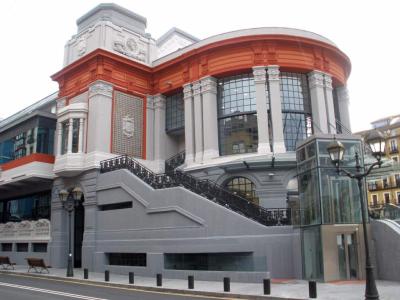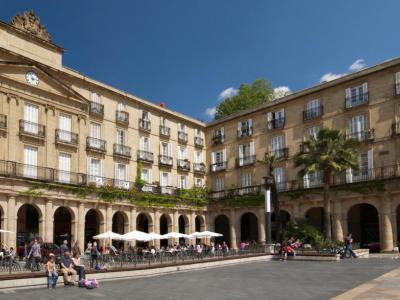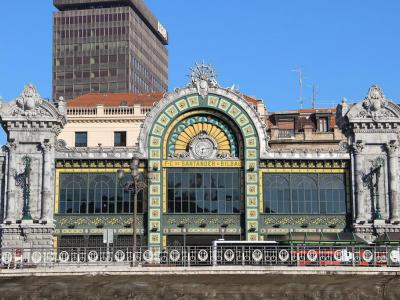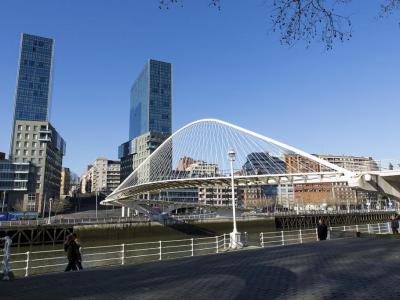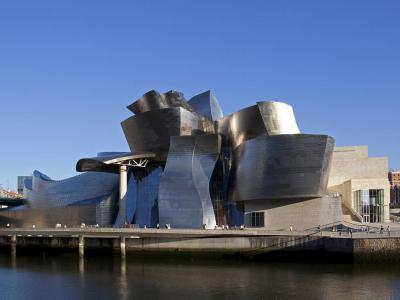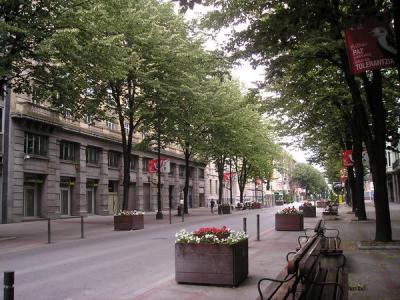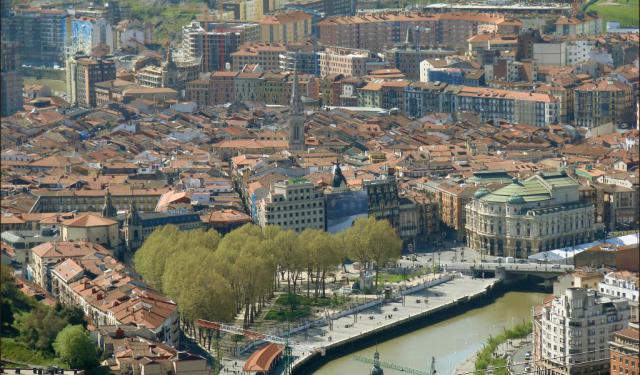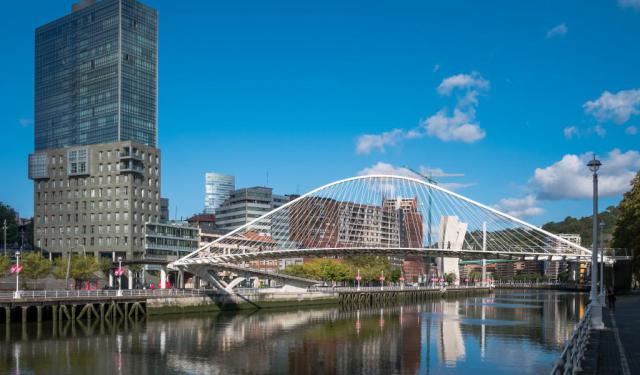
Bilbao Introduction Walking Tour (Self Guided), Bilbao
Bilbao is the largest city in northern Spain. Burial sites 6,000 years old have been found near Bilbao. A settlement of the 3rd or 2nd century BC was called Amanun Portus by the Roman writer Pliny the Elder. Ptolemy referred to it as Flaviobriga.
But today's Bilbao was founded on the banks of the Nervion River by the Lord of Biscay in the year 1300. The city was an important trading hub in northern Spain and a trading port with its trade with Flanders and Great Britain.
Bilbao can be divided into two distinct areas: the left bank is factories and the working class. The right, western bank holds the heart of the Old Town, the "Seven Streets." The 700-year-old district has buildings showing a variety of styles: Gothic, Art Nouveau, Art Deco, Neo-Gothic, Romanesque, and Renaissance.
The oldest buildings include the Saint James Cathedral, the Church of San Anton by the San Anton Bridge, and the Basilica of Begona. Besides the double-arched San Anton Bridge, there are 17 others, including Zubizuri, the pedestrian "White Bridge" over the Nervion River.
Museums start with the ultra Modernist, titanium-wrapped Bilbao Guggenheim Museum on the bank of the river. The Bilbao Fine Arts Museum shows works from the 12th century to the present. The Museo Archeologico is located in the Casco Viejo quarter. The opera house Arriaga Theatre should not be missed.
Bilbao is a city of festivals and events. The main one is the nine-day "Great Week" event at the end of August. The feast of Saint Agatha is in February, and Our Lady of Begona is in October. Christmas includes the Basque Santa. At least 13 festivals are celebrated locally, with the latest addition, The International Film Festivals of Bilbao.
The Ensanche neighborhood of Bilbao is the lively center of town. For eating and shopping, walk through Grand Avenue and explore the ancient side streets. The Market La Ribera at the south end is the oldest indoor market in Europe. Finish a stroll through old Bilbao with a lunch stop at the market.
The Catholic Monarchs described the Bilbao as "Very noble" and "Very loyal." After the Carlist Wars in the mid-19th century, the city was called "Unbeaten." After a one-week stay in August, one might say, "Unbeatable."
But today's Bilbao was founded on the banks of the Nervion River by the Lord of Biscay in the year 1300. The city was an important trading hub in northern Spain and a trading port with its trade with Flanders and Great Britain.
Bilbao can be divided into two distinct areas: the left bank is factories and the working class. The right, western bank holds the heart of the Old Town, the "Seven Streets." The 700-year-old district has buildings showing a variety of styles: Gothic, Art Nouveau, Art Deco, Neo-Gothic, Romanesque, and Renaissance.
The oldest buildings include the Saint James Cathedral, the Church of San Anton by the San Anton Bridge, and the Basilica of Begona. Besides the double-arched San Anton Bridge, there are 17 others, including Zubizuri, the pedestrian "White Bridge" over the Nervion River.
Museums start with the ultra Modernist, titanium-wrapped Bilbao Guggenheim Museum on the bank of the river. The Bilbao Fine Arts Museum shows works from the 12th century to the present. The Museo Archeologico is located in the Casco Viejo quarter. The opera house Arriaga Theatre should not be missed.
Bilbao is a city of festivals and events. The main one is the nine-day "Great Week" event at the end of August. The feast of Saint Agatha is in February, and Our Lady of Begona is in October. Christmas includes the Basque Santa. At least 13 festivals are celebrated locally, with the latest addition, The International Film Festivals of Bilbao.
The Ensanche neighborhood of Bilbao is the lively center of town. For eating and shopping, walk through Grand Avenue and explore the ancient side streets. The Market La Ribera at the south end is the oldest indoor market in Europe. Finish a stroll through old Bilbao with a lunch stop at the market.
The Catholic Monarchs described the Bilbao as "Very noble" and "Very loyal." After the Carlist Wars in the mid-19th century, the city was called "Unbeaten." After a one-week stay in August, one might say, "Unbeatable."
How it works: Download the app "GPSmyCity: Walks in 1K+ Cities" from Apple App Store or Google Play Store to your mobile phone or tablet. The app turns your mobile device into a personal tour guide and its built-in GPS navigation functions guide you from one tour stop to next. The app works offline, so no data plan is needed when traveling abroad.
Bilbao Introduction Walking Tour Map
Guide Name: Bilbao Introduction Walking Tour
Guide Location: Spain » Bilbao (See other walking tours in Bilbao)
Guide Type: Self-guided Walking Tour (Sightseeing)
# of Attractions: 9
Tour Duration: 2 Hour(s)
Travel Distance: 4.1 Km or 2.5 Miles
Author: nataly
Sight(s) Featured in This Guide:
Guide Location: Spain » Bilbao (See other walking tours in Bilbao)
Guide Type: Self-guided Walking Tour (Sightseeing)
# of Attractions: 9
Tour Duration: 2 Hour(s)
Travel Distance: 4.1 Km or 2.5 Miles
Author: nataly
Sight(s) Featured in This Guide:
- Catedral de Santiago (Santiago Cathedral)
- Mercado de la Ribera (Ribera Market)
- Plaza Nueva (New Square)
- Estacion de Bilbao Concordia (Bilbao-Concordia Railway Station)
- Zubizuri (White Bridge)
- Puppy
- Museo Guggenheim Bilbao (Guggenheim Museum Bilbao)
- Parque Casilda Iturrizar (Casilda Iturrizar Park)
- Gran Vía (Grand Avenue)
1) Catedral de Santiago (Santiago Cathedral) (must see)
The Santiago Cathedral is a Roman Catholic church dedicated to the apostle Saint James the Greater. It is a stop on the Pilgrims' way to the shrine of Saint James of Compostela. Santiago Cathedral, built in 1379, is located in the Old Section of Bilbao.
The cathedral has a Latin cross plan with three naves. The naves are separated by supporting columns. The presbytery is within a nave and ambulatory. The Gothic cloister has two porticos. The religious temple represents the 15th-century Gothic and Gothic Revival architectural styles in the facade and spire.
The facade and rose window are Neo-Gothic in style. The ogival doorway is flanked by statues of Peter and Paul. The Neo-Gothic tower is a work of the architect Severino de Achucarro.
On the north side is the 16th-century Gothic portal, Angel Gate (Puerta del Angel). The large portico on the south side was built over the old necropolis in 1580. It acts as a buttress for the epistle nave. The southern portal is the Gothic style featuring flared archivolts and no tympanum.
The wide ambulatory houses eleven chapels. There is a total of 16 chapels in the cathedral, including the crypt-oratory. The cloister is attached to the north side of the building. The cloister garden is bounded by four vaulted bays. It has two accesses, from inside the church, and from the street, via the Angel Gate (Puerta del Angel).
The cathedral has a Latin cross plan with three naves. The naves are separated by supporting columns. The presbytery is within a nave and ambulatory. The Gothic cloister has two porticos. The religious temple represents the 15th-century Gothic and Gothic Revival architectural styles in the facade and spire.
The facade and rose window are Neo-Gothic in style. The ogival doorway is flanked by statues of Peter and Paul. The Neo-Gothic tower is a work of the architect Severino de Achucarro.
On the north side is the 16th-century Gothic portal, Angel Gate (Puerta del Angel). The large portico on the south side was built over the old necropolis in 1580. It acts as a buttress for the epistle nave. The southern portal is the Gothic style featuring flared archivolts and no tympanum.
The wide ambulatory houses eleven chapels. There is a total of 16 chapels in the cathedral, including the crypt-oratory. The cloister is attached to the north side of the building. The cloister garden is bounded by four vaulted bays. It has two accesses, from inside the church, and from the street, via the Angel Gate (Puerta del Angel).
2) Mercado de la Ribera (Ribera Market) (must see)
Seen from the front, on the bank of the Nervion Estuary, the Ribera Market looks like a Mississippi steamboat made of stone and glass. Built in 1929, it covers 10,000 square meters. It is the largest covered market in Europe. It was mentioned in the Guinness Book of Records in 1990 as the largest food market in the world.
The market is located on Ribera Street near the Main Square (Plaza Mayor), the Church of San Anton, and the Town Hall. The market houses the Conde de Mirasol Walkway and connects to the San Anton Bridge. Ribera Street is between the estuary banks and the buildings of the Old Town of Bilbao (Casco Viejo), also called the Seven Streets (Las Siete Calles).
The market of Bilbao has existed since the 14th century. It was referred to as the "nerve center" of the town and was described by 19th-century Bilbao composer and writer Emiliano de Arriaga as "a well-stocked market with whatever the most refined gourmet could desire." In the 1800s, an enclosure of iron and glass was built to house the market.
In 1928, a new market, designed by architect Pedro de Ispizua, was built in the trendy Rationalist style. The aim was open spaces without columns with good ventilation and natural lighting. Stained glass, latticework, and decorated facades made for an eclectic Art Deco appearance. In 2010 the market foundations were strengthened.
The market has never closed. Fishmongers are on the ground floor. There are fish, fresh and frozen, shellfish, and pickles. The first floor houses meat, delis, pastries, and preserves. The second floor offers fruits and vegetables, flowers, seeds, and grains; most products are brought directly from nearby villages.
There are also gourmet bar-restaurants in a space that, thanks to a recent initiative, is filled with the sounds of jazz daily.
The market is located on Ribera Street near the Main Square (Plaza Mayor), the Church of San Anton, and the Town Hall. The market houses the Conde de Mirasol Walkway and connects to the San Anton Bridge. Ribera Street is between the estuary banks and the buildings of the Old Town of Bilbao (Casco Viejo), also called the Seven Streets (Las Siete Calles).
The market of Bilbao has existed since the 14th century. It was referred to as the "nerve center" of the town and was described by 19th-century Bilbao composer and writer Emiliano de Arriaga as "a well-stocked market with whatever the most refined gourmet could desire." In the 1800s, an enclosure of iron and glass was built to house the market.
In 1928, a new market, designed by architect Pedro de Ispizua, was built in the trendy Rationalist style. The aim was open spaces without columns with good ventilation and natural lighting. Stained glass, latticework, and decorated facades made for an eclectic Art Deco appearance. In 2010 the market foundations were strengthened.
The market has never closed. Fishmongers are on the ground floor. There are fish, fresh and frozen, shellfish, and pickles. The first floor houses meat, delis, pastries, and preserves. The second floor offers fruits and vegetables, flowers, seeds, and grains; most products are brought directly from nearby villages.
There are also gourmet bar-restaurants in a space that, thanks to a recent initiative, is filled with the sounds of jazz daily.
3) Plaza Nueva (New Square) (must see)
Construction of the Neoclassical New Square began in 1828. The first stone was laid by King Fernando VII. The King's statue was to be in the center of the square. But Fernando died in 1833. A pond took center stage, replaced by a statue of Diego Lopez de Haro, founder of Bilbao, in 1890. Construction was ongoing. The square opened in 1851.
The New Square is surrounded by Askao Street (Calle Askao), Sombrereria Street (Calle Sombrereria), Fueros Street (Calle de los Fueros), and Correo Street (Calle del Correo). Sixty-four arches in colonnades with pintxos bars tucked underneath enclose the square. The main building of the Basque government on the New Square was replaced in 1890 by the Euskaltzaindia Palace, The Basque Royal Language Academy.
Every Sunday, there is a flea market in the square. There is a brisk trade-in of old books, coins, stamps, and even birds and flowers. Taverns, restaurants, and some unique shops nestle under the arches. Folkways events, festivals, and concerts are often hosted in the square. Since 2008, the Bilbao City Council has provided free Internet access via Wi-Fi in the New Square.
The New Square is surrounded by Askao Street (Calle Askao), Sombrereria Street (Calle Sombrereria), Fueros Street (Calle de los Fueros), and Correo Street (Calle del Correo). Sixty-four arches in colonnades with pintxos bars tucked underneath enclose the square. The main building of the Basque government on the New Square was replaced in 1890 by the Euskaltzaindia Palace, The Basque Royal Language Academy.
Every Sunday, there is a flea market in the square. There is a brisk trade-in of old books, coins, stamps, and even birds and flowers. Taverns, restaurants, and some unique shops nestle under the arches. Folkways events, festivals, and concerts are often hosted in the square. Since 2008, the Bilbao City Council has provided free Internet access via Wi-Fi in the New Square.
4) Estacion de Bilbao Concordia (Bilbao-Concordia Railway Station)
The Bilbao-Concordia Railway Station, also known as Santander Station, is the terminus for suburban lines offering medium and some long-distance services. The facade is Modernist in style and is considered an outstanding example of Belle Epoque architecture in Bilbao. The station was opened in 1898 and completed in 1902. It sits beside the Bilbao River.
The station idea was put forward by engineer Valentin Gorbeña. Gorbeña was also the builder of the Kadagua Railway. The station design was by architect Severino Achucarro. He had already assisted in the plan for the ensanche (widening) of the town in 1876. The name "Concordia" is from an agreement by investors to save the railway from bankruptcy.
The station is two stories high. The ground floor houses the main hall, cafeteria, ticket machines, and offices. The main entrance is on Bailen Street by the river. The rear access opens on Jose Maria Olavarri Street. Tracks and platforms are on the second floor.
The entrance facade is structured with painted iron masonry with large area openings for illumination. The center facade features a semicircular arch with a clock flanked by two lampposts. The pavilion has a Doric colonnade open to the platforms. The interior iron architecture has capitals featuring Hermes, the God of Commerce, and borders.
The station idea was put forward by engineer Valentin Gorbeña. Gorbeña was also the builder of the Kadagua Railway. The station design was by architect Severino Achucarro. He had already assisted in the plan for the ensanche (widening) of the town in 1876. The name "Concordia" is from an agreement by investors to save the railway from bankruptcy.
The station is two stories high. The ground floor houses the main hall, cafeteria, ticket machines, and offices. The main entrance is on Bailen Street by the river. The rear access opens on Jose Maria Olavarri Street. Tracks and platforms are on the second floor.
The entrance facade is structured with painted iron masonry with large area openings for illumination. The center facade features a semicircular arch with a clock flanked by two lampposts. The pavilion has a Doric colonnade open to the platforms. The interior iron architecture has capitals featuring Hermes, the God of Commerce, and borders.
5) Zubizuri (White Bridge) (must see)
"Zubizuri" is Basque for "White Bridge." It is also called the Campo Volantin Bridge. It is a tied arch pedestrian bridge over the Nervion River. Designed by architect Santiago Calatrava, the bridge connects Campo Volantin's right bank of the river with Urbitarte's left bank. Opened in 1997 the bridge is a curved walkway held by steel cables from an overhead arch.
The bridge is painted white. The walkway decking is margined on each side by translucent glass bricks set aglow at night. Each bank is provided with access ramps and stairs. The White Bridge offers pedestrians a convenient route from hotels to the nearby Bilbao Guggenheim Museum.
The bridge is 246 feet long. Thirty-nine cables hang from the steel arch. The aim of having the bridge is to connect the Ensanche district with the Campo de Volantin pedestrian area. The Campo area provides pleasant strolling on the bank of the Nervion. The project was completed in 1997, a few months before the Guggenheim Museum opened.
The broad center walkway of the bridge was eventually covered with a non-slip carpet. The narrow margins retained the glass tiles. The bridge is an iconic symbol of hope of renewal from the city's decline after the loss of its maritime industry.
The bridge is painted white. The walkway decking is margined on each side by translucent glass bricks set aglow at night. Each bank is provided with access ramps and stairs. The White Bridge offers pedestrians a convenient route from hotels to the nearby Bilbao Guggenheim Museum.
The bridge is 246 feet long. Thirty-nine cables hang from the steel arch. The aim of having the bridge is to connect the Ensanche district with the Campo de Volantin pedestrian area. The Campo area provides pleasant strolling on the bank of the Nervion. The project was completed in 1997, a few months before the Guggenheim Museum opened.
The broad center walkway of the bridge was eventually covered with a non-slip carpet. The narrow margins retained the glass tiles. The bridge is an iconic symbol of hope of renewal from the city's decline after the loss of its maritime industry.
6) Puppy
The Guggenheim Museum of Bilbao has a 16-ton flower puppy to guard it. The 43-foot-high West Highland White Terrier sculpture is the creation of Pop-Surrealist artist Jeff Koons. In "Puppy," Koons has joined topics like Topiary and dog breeding with Chia Pets and Kitschy greeting cards. His intent is "to entice" and to inspire "confidence."
Puppy has stood guard in front of the museum since 1997. He has been covered with a "skin" of flowers changed twice a year to fit the season. Pansies and primroses are for autumn and winter. Begonias, impatiens, and petunias serve for spring and summer. It takes 20 people and nine days to plant 38,000 flowers for Puppy's coat, all patchy and bright.
The Puppy is anchored in concrete. The substructure of stainless steel is wrapped in turf, mesh, and a textile medium that secures the inner coat and promotes plant growth. A web of plumbing feeds and waters the flowers. Puppy sits and waits for visitors to pose with him for selfies. Picture takers often back up to capture his image in full frame.
Puppy has stood guard in front of the museum since 1997. He has been covered with a "skin" of flowers changed twice a year to fit the season. Pansies and primroses are for autumn and winter. Begonias, impatiens, and petunias serve for spring and summer. It takes 20 people and nine days to plant 38,000 flowers for Puppy's coat, all patchy and bright.
The Puppy is anchored in concrete. The substructure of stainless steel is wrapped in turf, mesh, and a textile medium that secures the inner coat and promotes plant growth. A web of plumbing feeds and waters the flowers. Puppy sits and waits for visitors to pose with him for selfies. Picture takers often back up to capture his image in full frame.
7) Museo Guggenheim Bilbao (Guggenheim Museum Bilbao) (must see)
By 1991 Bilbao's once thriving maritime industrial area was decrepit. The Basque government sought to arrange with the Solomon R. Guggenheim Foundation to build a Guggenheim Museum in the depressed port area of the city. The museum was built by Grupo Ferrovial, a Spanish multinational company. King Juan Carlos I inaugurated the museum on 18 October 1997.
Five days before the opening, ETA militants shot police officer Jose Mara Aguirre Larraona. Officer Aguirre helped to foil a grenade attack on the museum. He died. The square in front of the museum is now Aguirre Square. The museum represents a victory for Bilbao.
The Guggenheim Foundation chose the Canadian-American architect Frank Gehry for the design. Thomas Krens, museum director, urged Gehry to come up with something "daring." The result was hailed as a "Deconstructivist" masterpiece. Art critic Calvin Tomkins from The New Yorker called the museum "a fantastic dream ship of undulating form in a cloak of titanium."
Gehry has said the curved, randomly shaped steel walls are meant to "catch the light." The interior is laid out around a vast well-lighted rose-shaped atrium. All things in the museum are arranged around the atrium. The resonance of the building's design with a great ship stranded on the shores of Bilbao is not random.
The museum unwraps its forms of stone, glass, and metal on a 350,000-square-foot site by the Nervion River. It is in the old industrial core of the city. It has 120,000 square feet of space dedicated to exhibitions. The exhibition spaces are in 19 galleries. Ten are traditional and finished in stone. Nine are clad in swirling titanium.
The museum houses "large-scale non-specific works by contemporary artists." This group of artists includes Richard Serra, Willem de Kooning, Mark Rothko, Clyfford Still, Francesco Clemente, Anselm Kiefer, and Jenny Holzer.
Five days before the opening, ETA militants shot police officer Jose Mara Aguirre Larraona. Officer Aguirre helped to foil a grenade attack on the museum. He died. The square in front of the museum is now Aguirre Square. The museum represents a victory for Bilbao.
The Guggenheim Foundation chose the Canadian-American architect Frank Gehry for the design. Thomas Krens, museum director, urged Gehry to come up with something "daring." The result was hailed as a "Deconstructivist" masterpiece. Art critic Calvin Tomkins from The New Yorker called the museum "a fantastic dream ship of undulating form in a cloak of titanium."
Gehry has said the curved, randomly shaped steel walls are meant to "catch the light." The interior is laid out around a vast well-lighted rose-shaped atrium. All things in the museum are arranged around the atrium. The resonance of the building's design with a great ship stranded on the shores of Bilbao is not random.
The museum unwraps its forms of stone, glass, and metal on a 350,000-square-foot site by the Nervion River. It is in the old industrial core of the city. It has 120,000 square feet of space dedicated to exhibitions. The exhibition spaces are in 19 galleries. Ten are traditional and finished in stone. Nine are clad in swirling titanium.
The museum houses "large-scale non-specific works by contemporary artists." This group of artists includes Richard Serra, Willem de Kooning, Mark Rothko, Clyfford Still, Francesco Clemente, Anselm Kiefer, and Jenny Holzer.
8) Parque Casilda Iturrizar (Casilda Iturrizar Park)
Dona Casilda was generous in her philanthropy. Hospitals, streets, and a theatre honor her. On the street where she lived, the plaque proclaims she shared her "great riches" with "the poor of the world." In 1907, the land donated by the philanthropist was used to create Dona Casilda Iturrizar Park. For many years, it was the only green place in the city.
The park's main characteristic is the 18th-century English garden style of greenery. Many of the trees are over 100 years old. In the park is a pond harboring several species of water birds and peacocks, giving the park the nickname "Parque de los Patos" ("Duck's Park"). A cybernetic fountain is surrounded by a shaded pergola.
A significant percentage of parkland was lost in the 20th century in the construction of the Bilbao Fine Arts Museum. The Museum was built entirely within the park itself. The four-lane highway Park Road intruded on the north side of the park. In 2006, the Abandoibarra project rejuvenated the depressed city and greatly enhanced the parking area.
The park's main characteristic is the 18th-century English garden style of greenery. Many of the trees are over 100 years old. In the park is a pond harboring several species of water birds and peacocks, giving the park the nickname "Parque de los Patos" ("Duck's Park"). A cybernetic fountain is surrounded by a shaded pergola.
A significant percentage of parkland was lost in the 20th century in the construction of the Bilbao Fine Arts Museum. The Museum was built entirely within the park itself. The four-lane highway Park Road intruded on the north side of the park. In 2006, the Abandoibarra project rejuvenated the depressed city and greatly enhanced the parking area.
9) Gran Vía (Grand Avenue)
Gran Via de Don Diego Lopez de Haro, named after the founder of the city, the lord of Biscay, forms the main shopping center of the extension of Bilbao, planned by the architects Alzola, Achúcarro, and Hoffmeyer. The street is 1.5 miles long and 164 feet wide. From the Bank of Bilbao Vizcaya Argentina (BBVA) in Circular Square (Plaza Circular), it goes through Moyúa Square and terminates at Sacred Heart Square.
Moyua Square is almost in the middle of Gran Avenue. It is 1,642 feet from the beginning and 2,628 feet from its end. The statue of the Sacred Heart aligns with the spire of the Basilica of Bogata, reminiscent of the Axe Historique in Paris, France.
The Gran Avenue shopping district includes adjoining streets. The area has banks, department stores, international and luxury brands, and high-end stores. Fashion accessories, clothes, jewelry, designer goods, footwear, household goods, and gourmet foods are all there. The district can be divided into three zones.
The adjoining streets around Circular Square, Buenos Aires Street, Principe Street, and Villarias Street offer distinct shopping experiences. The middle zone, between Circular Square and Moyua Square, includes the cross streets of Marques del Puerto and Astarloa. Parallel streets are Colon de Larreategi and Rodriguez Arias.
The Moyua Square and Sacred Heart Square connect to the busy adjacent streets of Ercilla (pedestrian), Maximo Aguirre, Doctor Achucarro, Licenciado Poza, and Iparraguire.
Moyua Square is almost in the middle of Gran Avenue. It is 1,642 feet from the beginning and 2,628 feet from its end. The statue of the Sacred Heart aligns with the spire of the Basilica of Bogata, reminiscent of the Axe Historique in Paris, France.
The Gran Avenue shopping district includes adjoining streets. The area has banks, department stores, international and luxury brands, and high-end stores. Fashion accessories, clothes, jewelry, designer goods, footwear, household goods, and gourmet foods are all there. The district can be divided into three zones.
The adjoining streets around Circular Square, Buenos Aires Street, Principe Street, and Villarias Street offer distinct shopping experiences. The middle zone, between Circular Square and Moyua Square, includes the cross streets of Marques del Puerto and Astarloa. Parallel streets are Colon de Larreategi and Rodriguez Arias.
The Moyua Square and Sacred Heart Square connect to the busy adjacent streets of Ercilla (pedestrian), Maximo Aguirre, Doctor Achucarro, Licenciado Poza, and Iparraguire.
Walking Tours in Bilbao, Spain
Create Your Own Walk in Bilbao
Creating your own self-guided walk in Bilbao is easy and fun. Choose the city attractions that you want to see and a walk route map will be created just for you. You can even set your hotel as the start point of the walk.
Bilbao's Old Town Walking Tour
Bilbao's old town, also known as The Seven Streets, is the medieval heart of the city. Indeed, this ancient neighborhood, a place where the city began and which had been fortified by walls until the late 19th century, today consists of seven main streets and many narrow alleys – called cantons (kantoi, cantón) – that connect them.
Often regarded as a jewel of Basque architecture and... view more
Tour Duration: 1 Hour(s)
Travel Distance: 1.6 Km or 1 Miles
Often regarded as a jewel of Basque architecture and... view more
Tour Duration: 1 Hour(s)
Travel Distance: 1.6 Km or 1 Miles
The Most Popular Cities
/ view all

